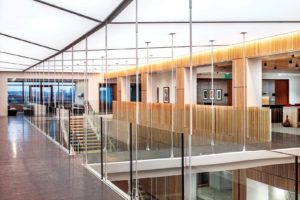
Fabrics have always been an essential component in commercial interior spaces. But, historically, their inclusion has been limited to more conventional roles, such as draperies and curtains, or flexible room dividers. With some exceptions, fabrics were not intended to serve as a focus in and of themselves. That has changed—decidedly. Fabrics are now looked to as a way to add drama and excitement to interiors, aided in no small measure by lighting strategies designed to heighten the effect.
Making a statement
According to Mar Ricketts, CEO and senior design principal of GuildWorks, interest in making a statement through the use of fabrics and lighting is stronger than ever. Located in Portland, Ore., the full-service design, specification, fabrication and installation enterprise specializes in exterior and interior fabric architecture, tension structures and fabric-formed environments (permanent and temporary) for commercial and civic settings, corporate offices, medical and hospital facilities, events and many other applications.
As Ricketts explains, building owners, operators and developers are looking for high-impact ways to make their buildings stand out and help attract the type of clientele, tenants and buyers they want. They’re also turning to fabric architecture and lighting to develop and establish their brand, he says, mentioning a project for a major software company where GuildWorks constructed a dynamic entrance into the building utilizing fabric and LED lighting, undertaken for the purpose of supporting that company’s image as an innovative and creative organization.
Another GuildWorks project took place at the University of Wisconsin. The company installed a fabric ceiling into a five-story event space. The ceiling pieces were much lower, imparting an intimate feeling for gatherings. GuildWorks also provided fabric wall pieces to block off a walkway, enabling students and faculty to use the building while an event was taking place and allowing attendees to feel separated from the foot traffic. The ceiling and wall pieces—which could be removed and reinstalled when desired—give a special feel to the space, especially when enhanced by the lighting, says Sky Reed, senior project representative for the company.
“When people walk through a space and experience 3-D fabric architecture, it opens up the imagination, and becomes a powerful tool for creativity,” he explains. “It brings a dynamic feel to an otherwise flat space.”
Interior fabric trends
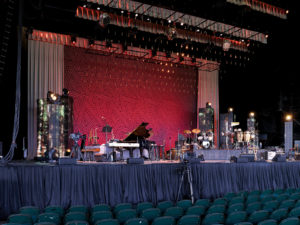
Ricketts says the majority of the fabrics his company uses are coated and uncoated fire-retardant polyesters. Joshua Alemany, director of products for Rose Brand, says IFR fabrics (inherently fire retardant) are most often specified, due to increased awareness of and concern over fire safety issues. Located in Secaucus, N.J., Rose Brand is a fabricator of custom curtains, backdrops, decor and super-wide digital print fabrics for the entertainment, event and architecture markets.
“The IFR materials are almost exclusively PET [polyethylene terephthalate],” says Alemany. “Wide widths allowing for seamless panels are also in demand. We’re seeing an increasing demand for even wider goods in the 5-meter range.”
Along with the more expected applications, such as draperies, Alemany says fabric is being used more frequently as skins on structures and walls, as well as fabric structural objects, with the fabric either digitally printed or solid. Fabric and lighting, commonly deployed in tandem in the entertainment world, are now appearing together more frequently in the architecture and hospitality arenas, he says.
“Typical use breaks into two categories: flat fabrics used as a surface for colored light or projected images and textures, or dimensional fabrics in fullness or layered designs, which create a dramatic sense of depth and dimension when lighted from above or on the side,” says Alemany.
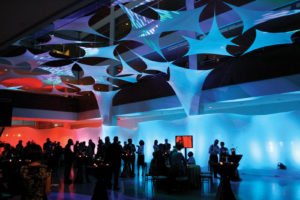
One fabric offered by Rose Brand is a custom jacquard, woven into a geometric pattern with three different shades of gray, that imparts a significant dimensional effect, says Alemany, describing it as “ideally suited for lighting effects” because of its gray surface. The material, used as a backdrop in the staging of a James Taylor concert at the Susquehanna Bank Center (now BB&T Pavilion) in Camden, N.J., can be lighted from the front, rear or above.
Paul Grider, director of product development for Dazian Creative Fabric Environments, a South Hackensack, N.J.-based provider of textiles and custom fabric services for the print, exhibit and entertainment industries, says Dazian is seeing a huge demand for fabrics that can be used in wide-format digital printing as well as video projection. Creative agencies and advertising companies are especially interested in these fabrics as they look for innovative ways to promote their clients and create “deeply submersive environments,” says Grider.
Fabrics offering multiple characteristics—such as recycled yarns or “materials that can be produced on greater than 3m wide”—are experiencing the most interest among his company’s clientele, says Marco Alvarez, president and CEO of Fabric Images Inc. Headquartered in Elgin, Ill., the company is a global solutions provider of printed and nonprinted custom tensioned fabric architecture.
“Another trend we see is the desire or design need to print on materials that are textile-based in nature but not truly classified as a fabric but are in the family of textiles,” Alvarez says, mentioning his company’s polyester-based acoustical product line favored for its ability to absorb sound in confined spaces.
“Designers are demanding more performance from the textiles to have a great impact on the environments they’re designing for,” he continues. “Fabric architecture is crossing the boundaries of many industries. In retail, it’s being utilized for large-scale applications as part of seasonal campaigns. In hospitality, custom-printed, brand-sensitive visuals are being printed on textiles via dye sublimation and latex sublimation printing processes. The evolution of print technology has opened up an entire realm of customization.”
Illuminate and project
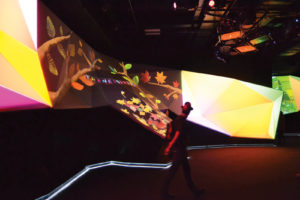
Fabrics and lighting can be combined in a variety of ways, says Alvarez. Most common is the desire to light the fabrics from the inside, such as a light box or something similar. However, Fabric Images is also fielding requests for custom applications involving front projectors that utilize augmented reality, interactivity or other technologies. He cites the company’s USA Pavilion at the Expo Milano as a good representation of the use of lighting, projection and textiles. Twelve angular tension fabric displays, ranging from 10 feet up to 60 feet in length and spanning 10 feet in height, were placed on the ground floor of the three-story pavilion.
“These flowed throughout the space acting as screens for projection-mapped video,” Alvarez explains. “Along the angular surfaces, the ever-changing imagery fell in line with each individual facet. The mapping of imagery began with the completion of engineer drawings of the framework. The manufactured structures were then married with the projections at install.”
Fabrics are also used to soften or diffuse daylight or electrical lighting, for example through the creation of light box solutions for ceiling and walls, as well as to help improve acoustics, says Peter Katcha, director of North American sales for SEFAR® Architecture in Depew, N.Y. The company manufactures monofilament precision and Teflon™ yarn fabrics and fabric systems for interior and exterior architectural applications.
“They are also being used to create diffusing solutions for new and existing skylights,” he says. “In both applications, acoustical benefits are a secondary design criteria desired.”
Inside outdoors
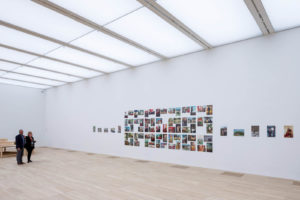
SEFAR offers a modular frame system for textile, translucent light ceilings and wall elements called LIGHTFRAME® that was selected by the designers of Tate Modern art gallery in London. The objective was to provide uniform illumination throughout the gallery from both skylight and artificial light sources. The LIGHTFRAME served as an illuminated modular fabric ceiling system, evenly diffusing light and improving acoustics.
In this way, fabric architecture fits in nicely with sustainability concerns, says Ricketts, explaining that although skylights can provide natural lighting they can also result in heat gain and energy increases, causing air conditioning costs to increase. This can be mitigated by fabric that will still let light through but also reduces heat gain.
“[Fabrics that seem most in demand] are those providing a range of photometric light levels, from 85 percent to 20 percent light transmission,” says Katcha. “Designers are also focused on the color trueness of the light diffused. Many fabrics will augment the color of the light as it passes through. True light color is particularly important for museum and gallery designers.”
Numerous fabric properties must be taken into account when lighting is part of the project, says Grant Harlow, director of marketing for Cooledge Lighting Inc., headquartered in Richmond, B.C., Canada, (U.S. offices are in Waltham, Mass.). The company’s “technologies and products enable large-scale digitally controlled luminous surfaces to bring the immersive illumination experience of the outdoors inside,” says Harlow. End users include the architectural and design markets as well as retail brands, property owners and hospitality chains.
The company’s ConAgra lobby in Omaha, Neb., is an example of bringing the outdoors in, achieved by devising a “luminous cloud” for the ceiling. “The knitted fabric ceiling created a ‘canopy of light’ that emulates the feeling of the natural illumination a person might experience outside,” Harlow explains.
The company creates luminous ceilings using two approaches: large-scale luminaries/light fixtures (“FABRICated Luminaires”) much larger than traditional fixtures, using knitted polyester fabric as the diffuser to create uniform light output, suspended or mounted directly into ceilings; and full luminous ceiling solutions where the ceiling materials—including fabric and LED lighting panels—are shipped to the site and then installed.
Fabric properties Harlow considers include aesthetic appearance, durability and the tendency to crease. However, the key characteristics weighed are:
• Transmission: The amount of light the fabric allows to pass through without being absorbed or reflected.
• Masking: The material’s ability to hide the light source behind it. “This is related to how much distance is required between the light source and the fabric so light sources can’t be seen as bright spots,” says Harlow.
• Reflectivity: Understanding this quality is essential for illumination systems, since light not directly transmitted through the fabric will be reflected back into the luminaire or ceiling cavity.
LED lights have become the standard for the illumination market, says Harlow. Grider confirms this, but he’s also noticing increased use of ultraviolet lighting in conjunction with fluorescent ink print graphics—although this has been so far largely confined to venues such as themed experiences, amusement parks and stage productions (“For best results, use a fabric that doesn’t glow under ultraviolet lighting,” he advises).
Different fabrics can affect a project’s outcome significantly, and in some cases dramatically, says Alvarez. “Textiles have evolved to be milled for specific uses of varying types of lighting. This is mainly for backlighting applications. However, not all textiles are created equal,” he cautions. “There are inexpensive and inferior fabrics as well as high-performance, smart textiles milled for performance and enhancement of lighting or projections.”
Pamela Mills-Senn is a freelance writer based in Long Beach, Calif.
When constructing a project, which is selected first, the fabric or the lighting?
It really depends on the project and situation. If timing permits, the fabric and lighting conversation is happening at the same time, testing is being done and we have time to make the educated decision. Most of the time, the fabric is being decided first, as it’s the skin to the structure—the surface the light will illuminate.
Paul Grider, Director of product development, Dazian Creative Fabric Environments
It depends. If it’s a workspace, then a lux value will determine the lighting levels needed in that space. A combination of fabric opacity and lumen value of the LEDs should achieve that desired lux amount. For other areas where a specific lux value isn’t mandated, the lighting designer will have more freedom to choose the fabric and light combination.
Peter Katcha, Director, North American sales, SEFAR® Architecture
Our experience has been that fabric and lighting are selected together at the time of design, unless the lighting is utilized in other parts of the space and serves a wider application within the environment. For example, spot directional lighting or theatrical lighting that is attached above to create an overall ambiance would take precedent over the fabric.
Marco Alvarez, President/CEO, Fabric Images Inc.
 TEXTILES.ORG
TEXTILES.ORG


